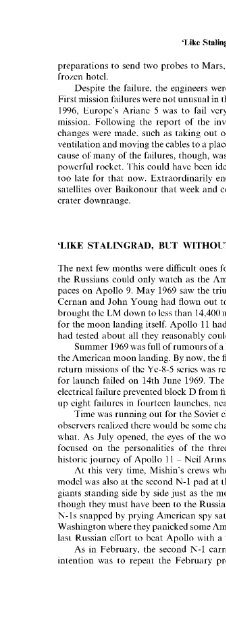Soviet and Russian Lunar Exploration
Soviet and Russian Lunar Exploration
Soviet and Russian Lunar Exploration
Create successful ePaper yourself
Turn your PDF publications into a flip-book with our unique Google optimized e-Paper software.
preparations to send two probes to Mars, had to work from a windowless <strong>and</strong> now<br />
frozen hotel.<br />
Despite the failure, the engineers were less discouraged than one might expect.<br />
First mission failures were not unusual in the early days of rocketry - indeed, as late in<br />
1996, Europe's Ariane 5 was to fail very publicly <strong>and</strong> embarrassingly on its first<br />
mission. Following the report of the investigating board in March, a number of<br />
changes were made, such as taking out one of the pipes that had failed, improved<br />
ventilation <strong>and</strong> moving the cables to a place where they could not be burned. The root<br />
cause of many of the failures, though, was the high vibration associated with such a<br />
powerful rocket. This could have been identified through ground-testing, but it was<br />
too late for that now. Extraordinarily enough, American intelligence did not have<br />
satellites over Baikonour that week <strong>and</strong> completely missed the launch <strong>and</strong> the fresh<br />
crater downrange.<br />
'LIKE STALINGRAD, BUT WITHOUT THE STUKA DIVE BOMBERS'<br />
The next few months were difficult ones for the <strong>Soviet</strong> space programme. In March,<br />
the <strong>Russian</strong>s could only watch as the Americans put the lunar module through its<br />
paces on Apollo 9. May 1969 saw the triumph of Apollo 10: Tom Stafford, Eugene<br />
Cernan <strong>and</strong> John Young had flown out to the moon, <strong>and</strong> Cernan <strong>and</strong> Stafford had<br />
brought the LM down to less than 14,400 m over the lunar surface in a dress rehearsal<br />
for the moon l<strong>and</strong>ing itself. Apollo 11 had been set for 16th July <strong>and</strong> the Americans<br />
had tested about all they reasonably could before actually touching down.<br />
Summer 1969 was full of rumours of a last ditch <strong>Soviet</strong> effort to somehow upstage<br />
the American moon l<strong>and</strong>ing. By now, the first of the Lavochkin design bureau sample<br />
return missions of the Ye-8-5 series was ready. The first such moonscooper prepared<br />
for launch failed on 14th June 1969. The craft failed to even reach Earth orbit: an<br />
electrical failure prevented block D from firing. The Proton booster had now notched<br />
up eight failures in fourteen launches, nearly all of them mooncraft.<br />
Time was running out for the <strong>Soviet</strong> challenge - whatever that was. In the West,<br />
observers realized there would be some challenge, though no one seemed sure exactly<br />
what. As July opened, the eyes of the world began to turn to Cape Canaveral <strong>and</strong><br />
focused on the personalities of the three courageous Americans selected for the<br />
historic journey of Apollo 11 - Neil Armstrong, Michael Collins <strong>and</strong> Edwin Aldrin.<br />
At this very time, Mishin's crews wheeled out the second N-1. An engineering<br />
model was also at the second N-1 pad at the time. Spectacular pictures show the two<br />
giants st<strong>and</strong>ing side by side just as the moon race entered its final days. Impressive<br />
though they must have been to the <strong>Russian</strong>s gathered there, photographs of the two<br />
N-1s snapped by prying American spy satellites must have created near apoplexy in<br />
Washington where they panicked some American analysts to speculate on a desperate,<br />
last <strong>Russian</strong> effort to beat Apollo with a man on the moon.<br />
As in February, the second N-1 carried another L-1S <strong>and</strong> a dummy LK. The<br />
intention was to repeat the February profile with a lunar orbit <strong>and</strong> return. Was







